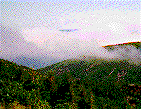Cool & Moist
The climate in the maritime region is moderated by the surrounding ocean.
As a result, the northern forest takes on a different complexion here.

|
Typical trees of this area
|
- RED SPRUCE
- Spruces are found throughout Canada up to the far north. Red spruce is
found predominantly in moist uplands. It can grow up to 25m (80 ft) and as old
as 300 years. Its range extends south into the Appalachians. It is the provincial
tree of Nova Scotia.
- BALSAM FIR
- Also found in the Boreal Forest.
- MAPLES
- YELLOW BIRCH
- Prefers rich moist soils. Its bark does not peel as easily as the so-called paper
birches. Yellow Birch grows rather large for a birch, up to 25m (80 ft). It has
wide spreading roots. This is the provincial tree of Québec (bouleau jaune).
Who eats Who?
Several different kinds of insects eat these trees.
Birds come to eat the insects and also the seed cones.
As far as we know, the spruce budworm has lived in North American spruce-fir
forests for thousands of years. Most of the time, their population stays fairly low.
Periodically, areas will experience a population boom, resulting in tree loss to
the voracious appetite of the budworm larvae. Originally, DDT was used to try to
control budworm outbreaks. More recently, Fenitrothion was used. An undesirable
byproduct of this new insecticide was decreased commercial blueberry production
in nearby areas. Two unexpected side-effects of the use of the insecticide which
resulted in this decrease were:
- high fatality rates of native bees and bumblebees which serve as pollinators for
blueberries and other plants.
- increased consumption of blueberries by birds, who may have been more numerous
due to the elimination of insects which controlled bird populations through
parasitism and transmission of diseases.
Related Information
![[home]](gsbann.gif)


![[home]](gsbann.gif)